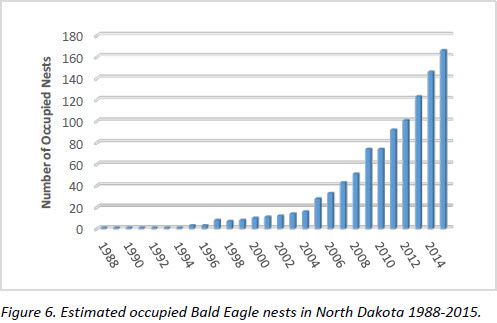
Bald Eagle
| Scientific Name | Haliaeetus leucocephalus |
|---|---|
| General Description | L 31”, WS 80”, 9.5 lb. Snow-white head and tail against a dark brown body. |
| Status | Both year-round and migratory. Peak breeding season early March to July. |
| Abundance | Fairly common to uncommon. |
| Primary Habitat | Large rivers and lakes or wetlands bordered by mature stands of trees such as cottonwood. |
| Federal Status | Migratory Bird. Additional protection under the Bald and Golden Eagle Protection Act. |
| Reason for Designation | The Bald Eagle was removed from the endangered species list on August 9, 2007. However, post-delisting monitoring must continue to ensure Bald Eagles are recovering. This is the primary reason why the species remains on the list. It is also a Partners in Flight (PIF) Stewardship species. |
Locations and Conditions of Key Habitat
Preferred Habitat
Bald Eagles prefer large rivers and lakes or wetlands bordered with mature stands of trees, or a single large tree, such as cottonwood. Breeding habitat often includes some type of edge and relatively open canopy. The large nests are usually built within the top quarter of tall, living trees, with fewer nests in dead trees. Nests are relatively close to water, typically less than 2 km. Bald Eagles are opportunistic and feed on a variety of fish, mammals, birds, and carrion.
Key Areas and Conditions for Bald Eagles in North Dakota
The Missouri River system including Lake Sakakawea, the Heart River, Cannonball River, Sheyenne River, Red River, Souris River, and the Devils Lake basin are key nesting areas. However, Bald Eagles are initiating nests in areas not considered traditional nesting habitat such as small stands of large cottonwood trees completely surrounded by cropland or grassland.
Problems Which May Affect this Species
Habitat
Development along the Missouri River and other wooded areas could may result in the loss of nesting, roosting, and associated aquatic foraging habitat. The lack of riparian regeneration may limit number of mature cottonwoods in the future. Large shelterbelts are being removed for agricultural expansion.
Other Natural or Manmade Factors
The use of the pesticide DDT was detrimental to Bald Eagles, causing the thinning of eggshells. Since the ban of DDT, Bald Eagles and many other raptors have rebounded. Eagles are infrequently killed by humans and the illegal trade of eagle parts for Native American purposes is of some concern. Intentional or accidental poisoning is responsible for some mortality. Lead poisoning continues to be reported, indicating eagles may be obtaining lead via a non-waterfowl source. Collisions with vehicles due to eagles eating carrion along roadsides, flying into power lines or electrocution from power lines constitutes a substantial source of mortality. Collisions with wind turbines is of increasing concern. Human activity such as recreational viewing, research activities, noise, agricultural or construction activities, or the mere presence of humans may agitate nesting eagles if the disturbance is close (less than 330 ft.) and/or persistent. This may result in eagles being inadvertently flushed from the nest for extended periods of time and could result in the death of young or nest abandonment.
Research and Survey Efforts
Current Research or Surveys
- The NDGF maintains the statewide database of known Bald Eagle nests in cooperation with the USFWS (USFWS March 2009). Potential nesting habitat is surveyed via fixed-wing aircraft in late April/early May on a rotational basis (i.e. a complete statewide aerial survey is not conducted annually). The NDGF requests the public to report nesting Bald Eagles. The majority of nests in non-traditional habitat are reported from the public.
Previous Research or Surveys
- The NDGF participated in the Midwinter Bald Eagle Survey from 1986-2013. The survey was flown around January 10 of each year from Bismarck to Garrison Dam. Anywhere from 2 to 108 Bald Eagles utilizing the Missouri River in winter have been counted in past years. The NDGF discontinued participation in the survey in 2014 due to stable and increasing numbers of Bald Eagles wintering across the state.
- Numerous published reports and gray literature throughout the species range, one of the most studied avian species.
Additional Research or Surveys Needed
Since the Bald Eagle is increasing in North Dakota, there are no urgent research needs or additional surveys planned. However, demographic information is unknown such as nest success, food habits, or an analysis of non-traditional nesting habitat.
Population and Trend Estimates

- PIF Global Population Estimate: 300,000
- North Dakota Population Estimate: unknown (total number of adults, sub-adults, and juveniles)
- North Dakota Number of Occupied Nests: ~165: see figure 6.
Management Recommendations
- Minimize impacts to nesting Bald Eagles from development activities (see USFWS 2007).
- Preserve mature stands of tall trees, but ensure regeneration of new trees.
- Utility development should follow the guidance of “Suggested Practices for Avian Protection on Power Lines: The State of the Art in 2006” and “Reducing Avian Collisions with Power Lines” including marking power lines and creating an Avian Protection Plan.
- Wind industry companies should collaborate with the American Wind and Wildlife Institute for responsible wind development and follow the USFWS “Eagle Conservation Plan Guidance.”
Monitoring Plans
Continue to maintain a list and spatial database of known Bald Eagle nest sites.
2005-2015 Progress
The Bald Eagle remains a Level II Species of Conservation Priority. The number of Bald Eagle nests have increased significantly over the past 10-15 years. The Bald Eagle population is currently secure in North Dakota.

Note: A listing of works consulted when compiling the information on this page may be found in the 2015 State Wildlife Action Plan.
Report Active Bald Eagle Nests
